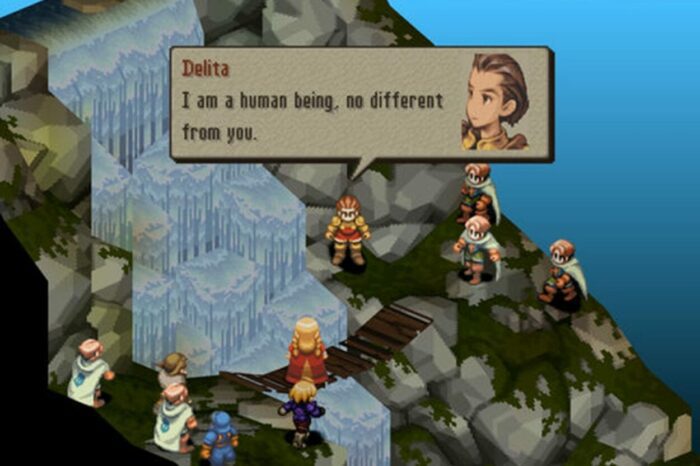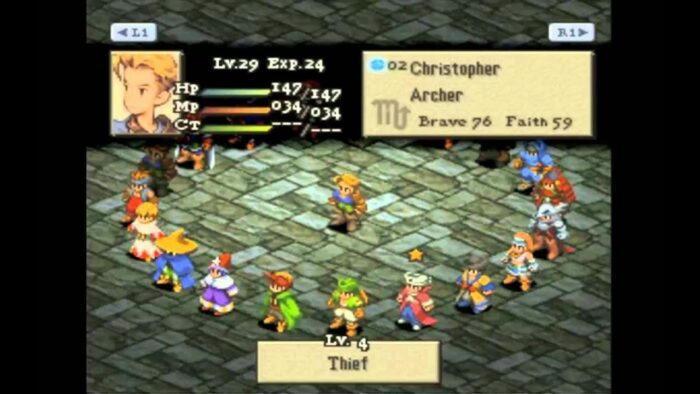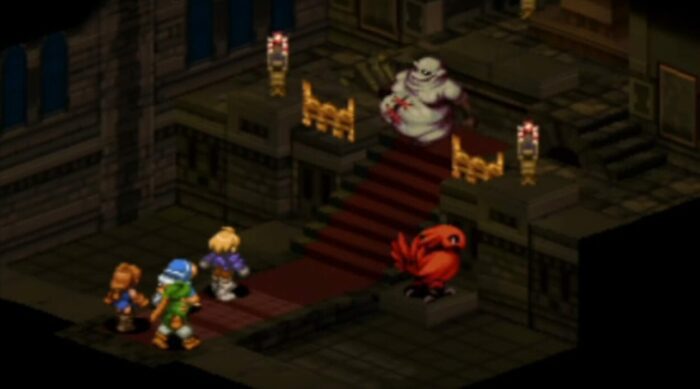Early Final Fantasy titles such as Final Fantasy IV and VI pushed the boundaries for what was possible for role-playing games in terms of storytelling and character development. Final Fantasy VII blew our minds, expanding the scope of what an RPG could be. Then came Final Fantasy Tactics.
On the surface, it would appear that Final Fantasy Tactics is a step back from Final Fantasy VII, given its more cartoonish and sprite-like graphics and radically changed gameplay style. But that is far from the case.
For years, I had considered Final Fantasy Tactics to be my favorite RPG—if not my favorite overall video game—of all time. When I began preparing to write this article, it had been a long time since I played the game, and I was a little worried it wouldn’t hold up to those standards. I have enjoyed various strategy RPGs very much in the years in between—for example, I thought Wasteland 2 and Fire Emblem: Three Houses were outstanding.
But when I picked up Final Fantasy Tactics again after all these years, I was pleased to discover it hadn’t lost a beat. It still absolutely holds up. After my recent play-through, I’m not sure I would crown it my favorite game of all time, but it’s still definitely in my top three.
(Note: I used the PSP version—The War of the Lions—for my recently play-through, so I will be using the terms used in that version as opposed to the PS1 version.)
The Story
While the battles are the heart of Final Fantasy Tactics, the game’s story is told through various cut scenes. And it’s surprisingly good. The game takes place in Ivalice (which also ends up being the setting for Final Fantasy XII), a kingdom in the midst of the War of Lions. The story centers on Ramza Beoulve, a member of a respected family who uncovers the plot behind the war.

The story involves Ramza being accused as a heretic as he attempts to track down his kidnapped sister Alma. It features corruption, deception, and a whole lot of stabbings. The story is darker than most Final Fantasy games and a bit convoluted at times. But it definitely keeps things interesting and features memorable characters, such as Ramza’s childhood friend Delita and the pain-in-the-ass mercenary Gaffgarion. In addition, the game’s story gives off major Game of Thrones vibes at times, with families backstabbing each other to achieve political power. There are even a few moments that gave me Red Wedding flashbacks.
The game ends in a bit of an anti-climactic fashion, but I do enjoy the mysteriousness of it—with Orran wondering what happened to Ramza and then getting a brief glimpse of him and Alma riding off into the sunset on Chocobos.
Is This Really a Final Fantasy Game, Though?
With such a drastically different gameplay style, it’s fair to ask if Final Fantasy Tactics truly feels like a Final Fantasy game. Exploration is limited to moving from dot to dot on the world map. There’s no resting at inns or in tents/cabins. The traditional turn-based battle style of previous games is replaced by a unique strategy RPG format.
However, despite these differences, it still prominently features classic elements of the Final Fantasy series, such as Chocobos, Dragoons (with the jump skill—Kain from Final Fantasy IV was always a favorite of mine), behemoths, summoning spells, black mages that look like the mages from the NES Final Fantasy, even a character named Cid. Even though it is different from all of the previous Final Fantasy games, it provides plenty of Final Fantasy nostalgia.
And in one of the coolest game crossovers I’ve experienced, you have the ability of recruiting Cloud Strife, the protagonist from Final Fantasy VII. And it’s not simply an homage to Cloud as a character with the same name. It’s actually Cloud, drawn from a different dimension into the world of Final Fantasy Tactics. When you meet Cloud, he’s classified as a soldier and is mumbling madly about Sephiroth.
The only downside of this crossover is that it occurs fairly late in the game and takes a lot of work to make Cloud a viable character choice.
Gameplay
The game’s battles share elements found in many other strategic RPGs. With the battlefield set up as a grid with varying heights, each character can move a certain amount of squares and perform an action—attack, use an item, perform a special skill, etc. Unlike other strategy games in which all of your characters will all take their turn and then switch to the enemy’s characters taking a turn, Final Fantasy Tactics relies on Charge Time (CT) to determine which character is up next.
This factor leads to one of the game’s main strategic elements. Certain spells and abilities take time to cast. So you want to cast a huge fire spell on a group of enemies? Better make sure they don’t have an opportunity to move out of the way first (and likely kill you).
The battle format is pretty standard for a game like this. But what makes Final Fantasy Tactics such a great experience is the control you have over your party. Each character, including the main character Ramza, is assigned a job from a list of 22 possible jobs. (The PS1 version had 20 jobs, with the Dark Knight and Onion Knight being added to the War of the Lions version.)

Many RPGs these days allow endless customization options, from weapons to classes/jobs. Fire Emblem: Three Houses did this extremely well. But what I love about Final Fantasy Tactics in this regard is how quick and easy it is to make tweaks to your party. Jobs can be swapped in the blink of an eye. One battle you have a couple mages and some strong fighters; and in the next battle you can easily have a herd of ninjas and samurais fighting alongside a chemist.
To achieve this full array of job choices, it takes work. You can’t switch to the best jobs right from the start of the game. Beginning with basic jobs such as Squire, Chemist, and Knight, leveling up those particular jobs (by achieving job points in battle) in turn unlocks more advanced jobs and abilities.
My personal favorite job classes I most often turned to were Monk, Ninja, Dragoon, and Arithmetician. But the Arithmetician job class is one of the most fun—and broken—classes I’ve come across in a strategy RPG. Its skill allows the character to cast virtually any spell, with no charge time, from any spot on the battlefield. Targets of the skill are determined by a number of characteristics. For example, if you select “Level” and “Multiple of 3,” any character—friend or foe—that is at a level that’s a multiple of 3 will be targeted by the spell. Find the right combination, and you can instantly drop a Flare spell on the entire enemy team or heal your entire party.
The one downside to Arithmeticians is that it takes an inordinate amount of time to level up. Often, every other character may end up taking two turns before your Arithmetician takes their turn. But once all of the Arithmeticks Skills are learned, you can simply change jobs (I preferred to use a Black Mage) and assign the Arithmeticks Skill, and it’s pretty much game over for the enemy.
Special Characters
Through the early segments of Final Fantasy Tactics, you control Ramza and a ragtag group of generic characters, who you can make any job class you wish. But as you progress through the game, you bring aboard special characters who play roles in the overall story of the game and bring skills that are unique to them and not found in other jobs. This brings about another fun choice: whether to regularly include these special characters in your party or stick with your original group of soldiers you began the game with.
Personally, I welcome the use of special characters, as I feel like it adds some variety to the battles. I particularly enjoy deploying Agrias—a Holy Knight who joins early in the game—and Beowulf, a Templar who uses a wicked mix of magic and physical attacks.
My go-to party by the end of my recent play-through included Ramza (as a Monk with Dual Wield), a Black Mage with the Arithmeticks Skill, Orlandeau, Beowulf, and Agrias or a generic Ninja/Dragoon. This party was pretty much unstoppable, and I mowed through the enemy with glee.
Others may choose to avoid using the special characters to level the playing field late in the game. That’s the beauty of Final Fantasy Tactics: you can construct your party however you’d like and find success in multiple deployments—and, in turn, this provides an extremely high replay value.
Difficulty
As I hinted at, certain special characters make the battles in the later stages of Final Fantasy Tactics much easier. Setting Orlandeau as regular party member is a sure-fire way to ensure victory. Orlandeau, a Sword Saint, possesses battle skills that absolutely decimate enemies. And to top it off, he is equipped with an Excalibur sword, which permanently grants him Haste—allowing him to typically take the first turn of the battle and wipe out multiple enemies before they can bat an eye. Combine this with Beowulf’s ability to easily disable enemies (which prevents them from performing any action whatsoever), and many battles in the game’s final chapter are actually quite easy.
However, this contrasts with earlier sections of the game—something I had forgotten in the years since I last played Final Fantasy Tactics. During my recent play-through, I failed a frustratingly high number of battles in the opening couple of chapters. Some early battles include NPCs on your team that will make dumb decisions or that are not on a equivalent level to enemies.
And certain early-chapter boss battles can be incredibly difficult if you are unprepared. In one battle in Chapter 2, I repeatedly found the boss Cúchulainn immediately inflicting crippling status effects to half my party. Unfortunately I didn’t save a separate file before the battle, so I faced two choices: keep trying the battle and hoping I’d get lucky or start the game over entirely. Fortunately after about 20 attempts, the game’s algorithms decided to not make Cúchulainn turn half of my party to stone on the first turn, and I was able to defeat him.

To help combat some of the game’s early difficulty, Final Fantasy Tactics provides something not often found in strategy RPGs—grinding. Random encounters in previous Final Fantasy titles and other RPGs are often considered a major downside. But I have a confession: I love the random encounters in Final Fantasy Tactics. Through grinding, you can level up your characters and obtain the upper-level jobs and skills as quickly or slowly as you’d like.
If I were to have one specific complaint about Final Fantasy Tactics, it’s that the difficulty of the game is a little too uneven. The beginning is a bit too difficult at times, and the end is too easy. Especially when the battle objective is to kill one specific enemy, battles can sometimes be won on the very first turn. Of course, parties can be constructed in ways that would make the ending more difficult. There’s just a little too much disparity in this regard, I think.
I’m not sure I’ll ever find another game like Final Fantasy Tactics. The combination of customization (and the ease of achieving the customization), an engaging story, and heavy doses of Final Fantasy nostalgia creates one of the best strategy RPGs ever made. Its legacy is unmatched.


The PS1 FFT really frustrated me when I first played it. I remember the bosses level scaling with mine. In the psp version I’m pretty sure their levels were static so if you did grind it was a much easier time. I’d use a Samurai/knight, ninja/thief, summoner/calculator, Balthier/chemist, Dark Knight/and something fun, on standby I’d have some combination of orator/bard/dancer
This is easily my favourite game — ever. I’d love to see Square remake it for the PS5 or the Switch, or at least release a new entry in Tactics/Ivalice series.